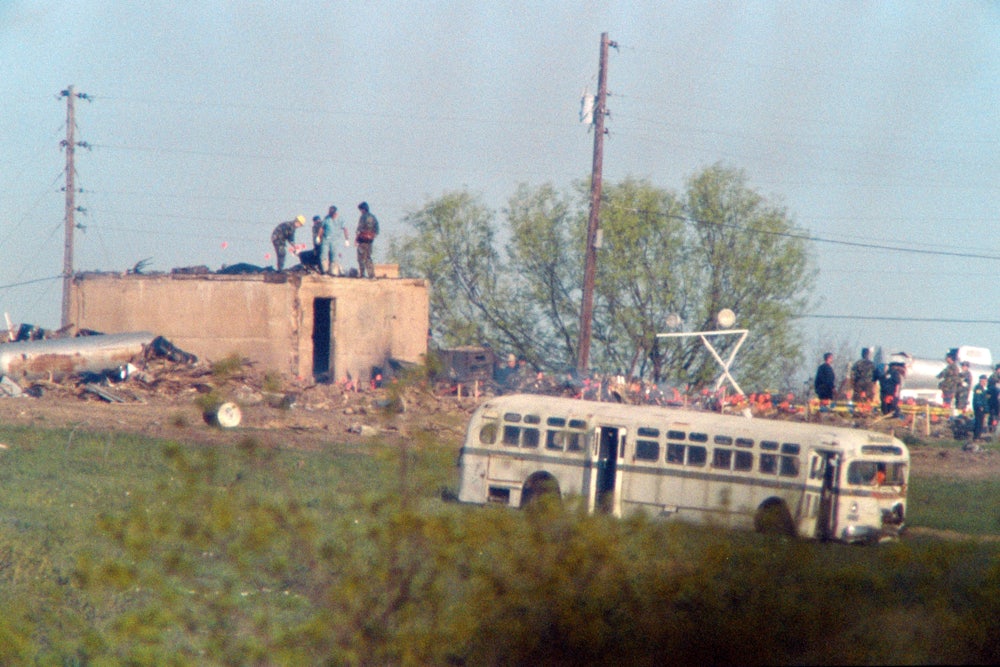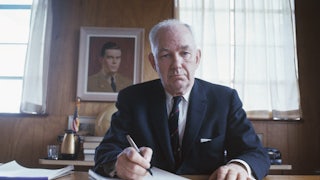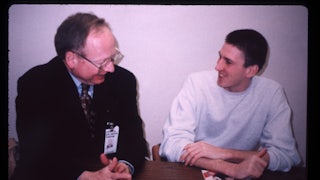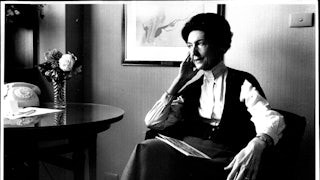David Koresh “may have been a false prophet, but he was onto something,” the current pastor of the Branch Davidians recently remarked at his congregation’s compound near Waco, Texas. “That’s why the Clintons couldn’t let him live. He knew too much about the human trafficking, pedophilia, and gun- and cocaine-running the Clintons and Bushes were guilty of.” In this diatribe, and in the many screeds he has written for his church’s website, Pastor Charles Pace explicitly connected the 1993 Waco siege—which killed 82 Davidians, including Koresh—with our paranoid present.
An engrossing and original new book by Kevin Cook examines this link in heroic detail and depth. For Cook, Koresh’s apocalyptic visions—and the brutal end he and his followers met in 1993—helped lay the groundwork for the distrust, disinformation, and denialism of the past decade. Cook’s account transports readers from the Davidians’ early days to the prolonged standoff that not only killed David Koresh and dozens of his followers but also radicalized countless right-wing extremists like Timothy McVeigh and Alex Jones.
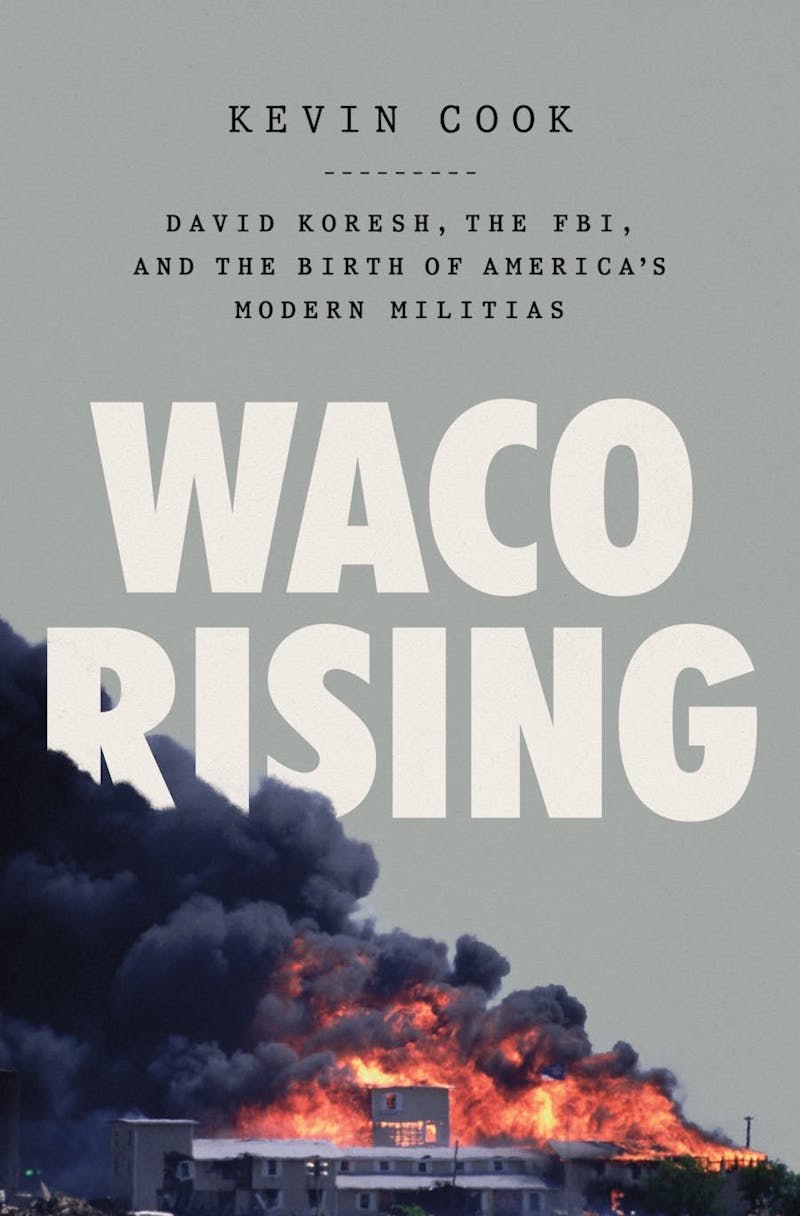
Along the way, Waco Rising poses vital and urgent questions about state power and the role of violence and warmaking in the contemporary United States. How can we oppose the sort of fanaticism and abuse that defined life at Koresh’s Mount Carmel Center without emboldening the security state? How can we resist state violence without empowering conspiracists and demagogues? And if Waco did, in fact, help set the stage for January 6 or November’s massacre at Club Q in Colorado Springs, what then? How can we transform this knowledge into a usable past that might help curb violence in all its forms?
The Waco siege was a tragedy long foretold. Victor Tasho Houteff, a Bulgarian immigrant to the United States, founded the Branch Davidians in 1935 after growing disillusioned with his Seventh-day Adventist congregation. Houteff and his followers settled on a plot of land near Waco, where the Davidians would live, worship, raise children, and prepare for the end times. In keeping with the Seventh-day Adventist tradition from which Houteff had emerged, the Davidians focused intently on the violent prophecies contained in the Book of Revelation, and they believed that the Second Coming was imminent.
Claiming to possess the power of prophecy, Houteff built a respectable following on Mount Carmel. When he died in 1955, his widow, Florence Houteff, took over. Insisting that she had inherited “his gift of prophecy,” Florence Houteff set a firm date for the Second Coming: April 22, 1959. Nearly one thousand Davidians—some of whom had sold their homes and businesses—made their way to Waco and Mount Carmel in anticipation of Christ’s return. But April 22 came and went—a twentieth-century Great Disappointment. The debacle severely undermined Davidians’ faith in Florence Houteff, who was soon succeeded by the Roden family—Benjamin, his wife, Lois, and their son George. The Rodens presided over the Branch Davidians until 1987, when Lois’s protégé—a young man named Vernon Howell—staged a violent raid on Mount Carmel and installed himself as the Davidians’ leader the following year. In 1990, he legally changed his name: From that point on, he was David Koresh.
Koresh’s five-year stint as head of the Branch Davidians was productive—and unfathomably tumultuous. Davidian survivors have explained that Koresh knew the Bible (especially its brutal conclusion, Revelation) backward and forward, and he was a highly effective teacher. “For true believers,” Cook writes, Koresh’s sermons and “Bible studies were better than any movie.” As one Davidian put it, “I learned more with him in one night than in a lifetime of going to church.” Koresh’s charisma, charm, and deep understanding of scripture all but guaranteed a devoted flock.
That devotion manifested itself in different, sometimes horrifying ways. Mount Carmel residents endured dismal living conditions. Their compound lacked indoor plumbing, which meant that Davidians urinated and defecated in outhouses and plastic buckets. Meals were spartan, and water scarce, while discipline, punishment, and abuse were never in short supply. Adults regularly paddled children, and Koresh demanded total obedience to his rigid yet arbitrary rules. Koresh also maintained a harem of women and girls, some as young as 12, and sired at least a dozen children.
This physical, psychic, and sexual violence fit seamlessly with the Davidians’ ambient sense of apocalyptic doom, obsession with firearms, and leeriness of the federal government. As historian Kathleen Belew has shown, the late 1980s and early 1990s represented a moment of uncertainty and transformation for white power, paramilitary, and anti-statist groups in the United States and beyond. With the perceived Communist threat all but vanquished, these groups insisted, the U.S. government would increasingly turn its warmaking powers inward, targeting deviant individuals and groups. The growing transfer of military weaponry to local and state law enforcement agencies in the early 1990s, along with the deadly August 1992 siege at Ruby Ridge, Idaho, lent credence to this interpretation. Against this backdrop, and amid fears that the government might curtail Americans’ access to firearms, Koresh and the Davidians sold weapons at gun shows throughout Texas. They also stockpiled firearms and trained for armed combat at the Mount Carmel compound. “Persecution is coming,” Koresh told his followers.
In a sense, he was right. A disgruntled former Davidian had notified the Bureau of Alcohol, Tobacco, and Firearms of Koresh’s unsavory activities, prompting an investigation that would yield search and arrest warrants. But when 76 ATF agents descended on Mount Carmel to execute these warrants in late February 1993, they unknowingly initiated what would become the deadliest U.S. government action on American soil since the 1890 massacre at Wounded Knee.
The February 1993 raid claimed the lives of four ATF agents and six Branch Davidians and triggered a 51-day standoff overseen by the FBI. The FBI siege ended with another raid and a catastrophic fire, in which an additional 76 Branch Davidians would perish. Waco Rising meticulously catalogs the misdeeds and missteps that precipitated the carnage. Humiliated on the national stage following the bloodshed at Ruby Ridge, federal law enforcement agencies “needed a big win,” one Davidian survivor noted. Although the ATF could have arrested Koresh with little fanfare on one of his regular jogs, the agency decided to go big with its February 1993 raid. A massive show of force, agents thought, would stun and incapacitate Koresh and his followers and help to rehabilitate the image of federal law enforcement. In reality, the well-armed Davidians were more than ready for a fight, and they delivered yet another black eye to federal agents.
The feds never forgave the Davidians. While some negotiators and other agents established a rapport with Koresh and showed a genuine interest in ending the standoff without further bloodshed, others taunted and antagonized those at Mount Carmel. Hubris drove the initial ATF raid and the decision to halt negotiations and flood the Davidian compound with tear gas on April 19, 1993. Virtually every step taken by federal law enforcement—the forces of Babylon, as Davidians called them—confirmed Koresh’s “prophecies” concerning religious persecution and an overzealous, callous, and incompetent federal government. “As the fire spread” through the Mount Carmel compound, Cook writes, “one of the largest government forces ever gathered on American soil did little but watch and wait.” Firefighters were kept at bay out of fear that the Davidians might fire upon them. Some “672 federal agents, 131 Texas Department of Safety officials, 31 Texas Rangers, 35 local police officers,” 15 U.S. Army soldiers, and 13 Texas National Guardsmen sat and stared as 76 people suffocated, suffered blunt-force trauma, burned to death, or died by suicide or “mercy killing.”
It is no surprise, then, that right-wing conspiracists and militia groups have long used Waco as a rallying cry. One slender 24-year-old hawked anti-government bumper stickers near Mount Carmel during the siege. “The ATF just wants a chance to play with their toys, paid for by government money,” he told a journalism student from Southern Methodist University in Dallas. “The government is afraid of the guns people have. I believe we are slowly turning into a socialist government. The government is continually growing bigger and more powerful, and the people need to prepare to defend themselves against government control.” On April 19, 1995—exactly two years after the final Waco raid—that same young man parked a Ryder truck packed with 4,800 pounds of ammonium nitrate fertilizer, nitromethane, and diesel fuel in front of the Alfred P. Murrah Federal Building in Oklahoma City.
The Waco siege also proved formative for Alex Jones, who was just 19 years old in 1993. By decade’s end, Jones had become somewhat of a local celebrity in Austin, gaining clout as a public access TV and talk radio host and right-wing provocateur. He ultimately lost his radio gig after launching a fundraising drive to construct a new church at Mount Carmel outside Waco. But not only did Jones succeed in building the Davidians a new home, which opened on April 19, 2000; he developed a significant national following through his Infowars website.
Today’s right-wing conspiracists and militias, Cook asserts, almost universally view Waco as a radicalizing event. “With Waco,” one FBI official noted, “you can go to YouTube and see women and children incinerated, the government using military tools and training against Americans.” The global “war on terror,” the Great Recession, the election of Barack Obama, and the solidification of the neoliberal order have intensified this radicalization, paving the way for the Tea Party, Trumpism, the so-called alt-right, QAnon, the insurrection of January 6, 2021, and increasingly naked expressions of racism, antisemitism, homophobia, transphobia, and sexism.
Ultimately, as one Department of Homeland Security official put it, “The modern-day militia movement owes its existence to Waco,” and that movement is evolving in troubling ways. “Now they’re taking the fight to local school boards and county councils, mainstreaming ideas that would have seemed fringe a few years ago.” Militias are now “blending with QAnon,” another national security expert explained, “people who see Democrats as child-abusing predators.” It is not difficult, then, to trace a direct line between Waco and the January 6 insurrection (in which so many QAnon believers participated) or the anti-gay, anti-trans panic currently buffeting the nation.
The obscene, baseless conspiracies propagated, and racist violence perpetrated, in the Davidians’ name should anger any observer. So too should the state violence that has fueled such responses. How can we reconcile these two seemingly contradictory truths?
While Waco Rising draws a clear link between the Mount Carmel siege and the right-wing movements of today, it doesn’t explore, in any meaningful depth, how whiteness has shaped the right’s responses to government “overreach.” As Belew argues, Black and brown people had been the main victims of state violence long before and long after Ruby Ridge and Waco—from the lynching of 38 Indigenous men during the 1862 U.S.–Dakota War to the violent clampdown on the 1960s Black freedom struggle, to the death and destruction wrought by the “war on terror.” Yet in the main, white power and paramilitary groups have only taken umbrage when the government sets its sights on white people—especially white women and children. To that end, far-right actors have often imagined the Branch Davidians as exclusively white.
Yet, although its highly visible leader was white, the congregation at Mount Carmel was incredibly diverse. (People of color made up about half of Koresh’s flock.) As federal agents laid siege to the Mount Carmel compound, the Davidians hung a bedsheet from a window that read, “RODNEY KING WE UNDERSTAND”—an allusion to the unarmed Black motorist whose vicious beating at the hands of four white police officers (and their subsequent acquittal) touched off the 1992 Los Angeles rebellion.
Cook never speculates on what exactly the Davidians may have meant by this. But the gesture indicates that the Davidians explicitly understood their struggle in relation to Rodney King’s. And that—far from being the example of whiteness under siege that the right imagines—Waco fit into familiar patterns of state violence and repression, to which people of color, queer people, and other minority populations were and are disproportionately subjected. We don’t have to idealize Koresh or his followers to acknowledge their victimization—or to link it to that of Rodney King, Tamir Rice, Eric Garner, Michael Brown, Elijah McClain, Breonna Taylor, George Floyd, and the countless individuals ensnared in America’s “crimmigration” and carceral machinery. By articulating a broader critique of state power, one that folds in Waco, we can take away one of the right’s most powerful claims. Only then can we confront the violence that produced Waco and the violence that Waco has produced.
